Professional IT Culture: Analyzing Ethics and Applying the SFIA6 Model
VerifiedAdded on 2023/06/06
|11
|2063
|438
Report
AI Summary
This report delves into the ethical dimensions of professional IT culture, focusing on a case study involving a product release with known bugs and its subsequent consequences. It identifies key stakeholders, analyzes their ethical responsibilities, and explores the ethical dilemmas they face. Furthermore, the report outlines ethical responses and references the ACS code of ethics. The second part of the report discusses the SFIA6 framework, which provides guidance for IT professionals in developing their skills and careers. It highlights the framework's purpose, levels, and key sections, emphasizing the importance of aligning skills and knowledge with industry standards. Desklib offers a wealth of similar solved assignments and resources for students.
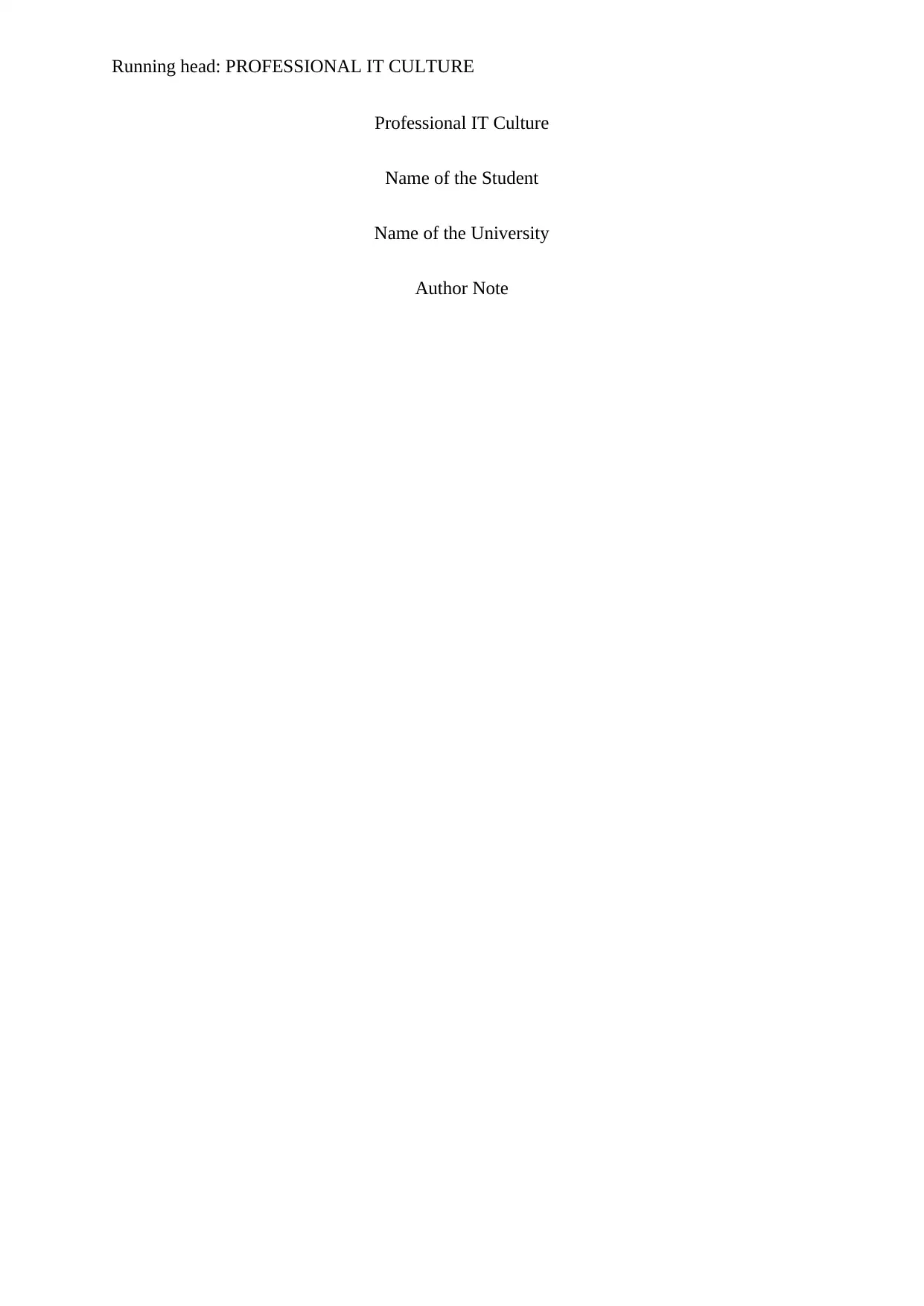
Running head: PROFESSIONAL IT CULTURE
Professional IT Culture
Name of the Student
Name of the University
Author Note
Professional IT Culture
Name of the Student
Name of the University
Author Note
Paraphrase This Document
Need a fresh take? Get an instant paraphrase of this document with our AI Paraphraser

1PROFESSIONAL IT CULTURE
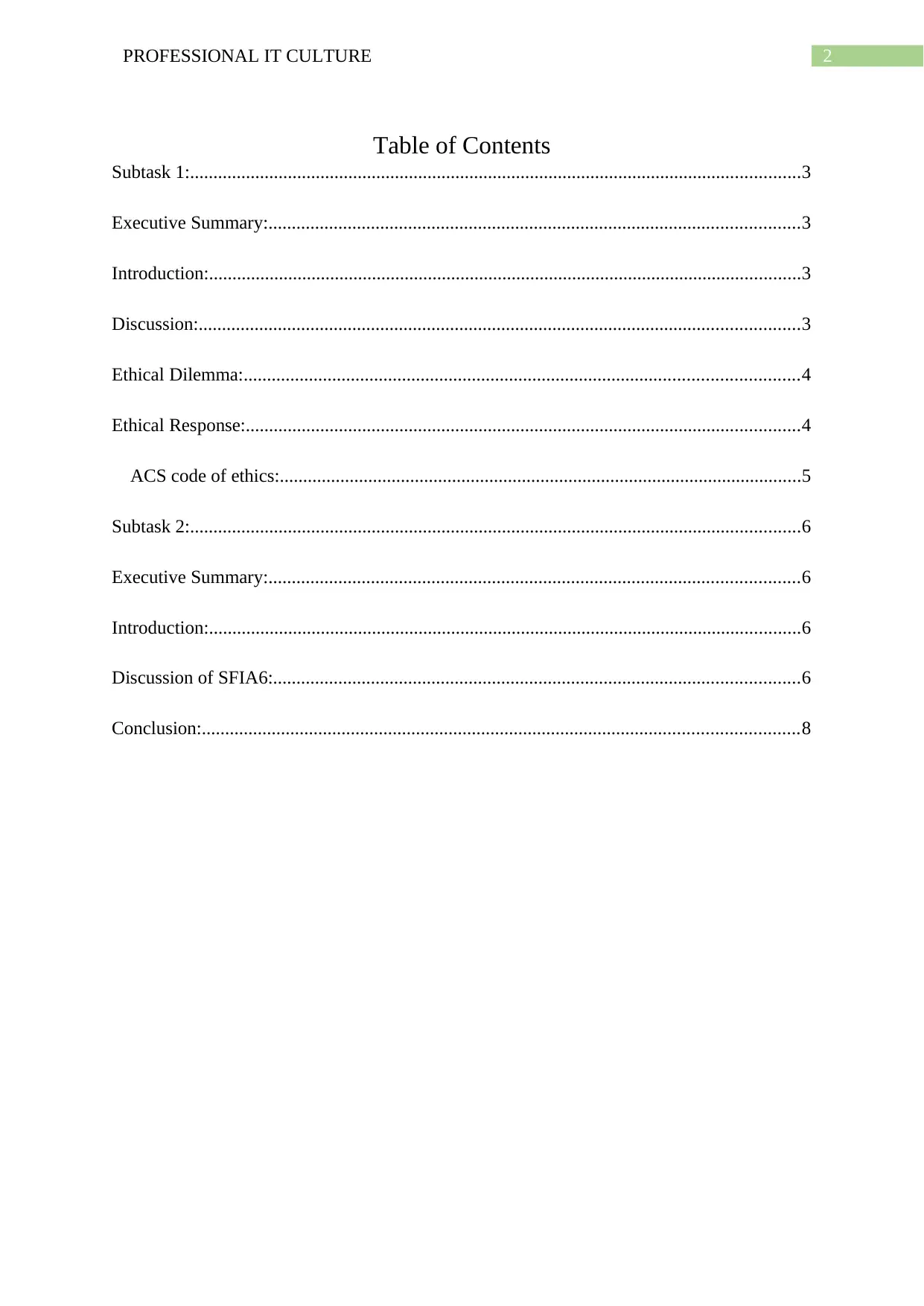
2PROFESSIONAL IT CULTURE
Table of Contents
Subtask 1:...................................................................................................................................3
Executive Summary:..................................................................................................................3
Introduction:...............................................................................................................................3
Discussion:.................................................................................................................................3
Ethical Dilemma:.......................................................................................................................4
Ethical Response:.......................................................................................................................4
ACS code of ethics:................................................................................................................5
Subtask 2:...................................................................................................................................6
Executive Summary:..................................................................................................................6
Introduction:...............................................................................................................................6
Discussion of SFIA6:.................................................................................................................6
Conclusion:................................................................................................................................8
Table of Contents
Subtask 1:...................................................................................................................................3
Executive Summary:..................................................................................................................3
Introduction:...............................................................................................................................3
Discussion:.................................................................................................................................3
Ethical Dilemma:.......................................................................................................................4
Ethical Response:.......................................................................................................................4
ACS code of ethics:................................................................................................................5
Subtask 2:...................................................................................................................................6
Executive Summary:..................................................................................................................6
Introduction:...............................................................................................................................6
Discussion of SFIA6:.................................................................................................................6
Conclusion:................................................................................................................................8
⊘ This is a preview!⊘
Do you want full access?
Subscribe today to unlock all pages.

Trusted by 1+ million students worldwide
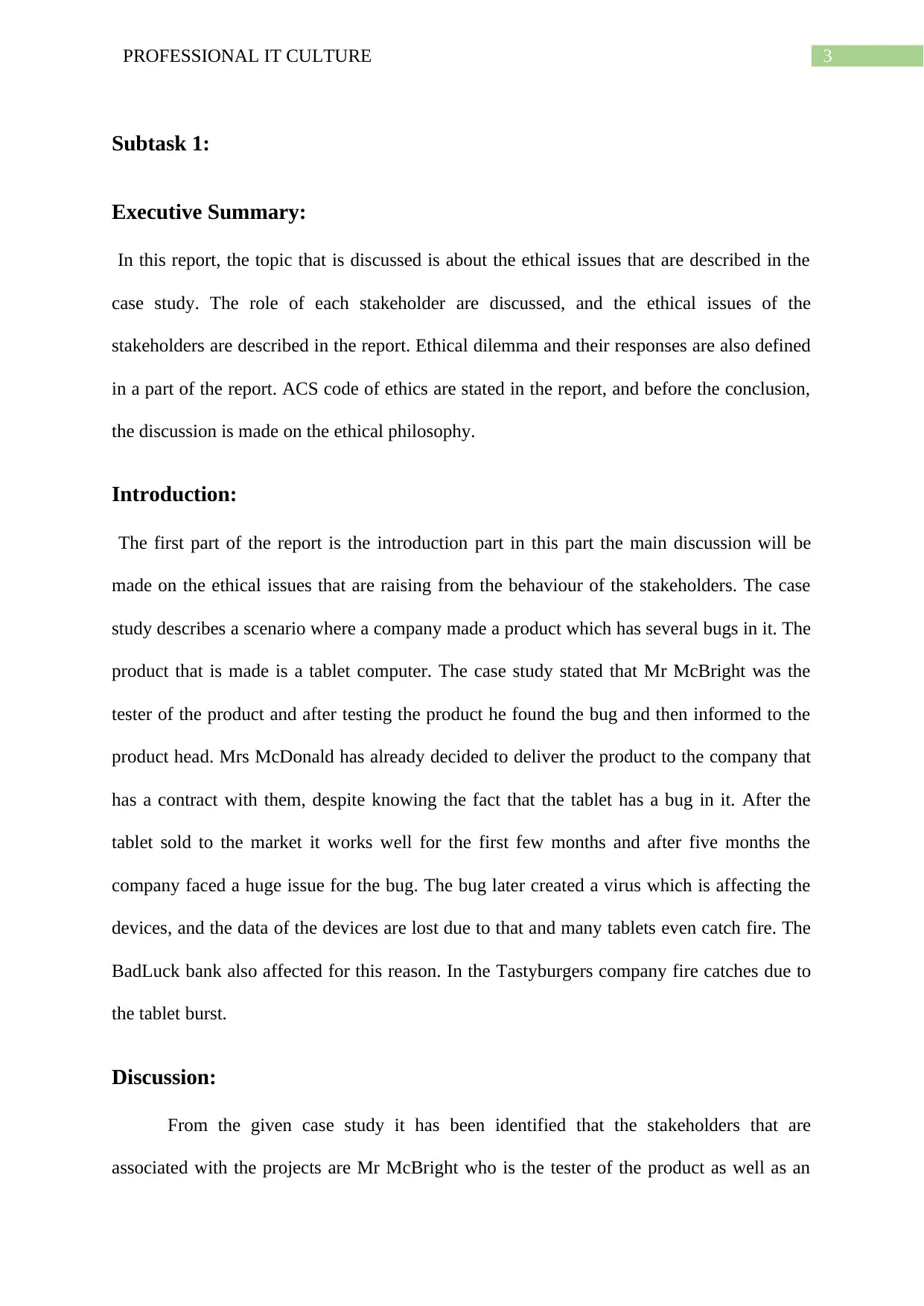
3PROFESSIONAL IT CULTURE
Subtask 1:
Executive Summary:
In this report, the topic that is discussed is about the ethical issues that are described in the
case study. The role of each stakeholder are discussed, and the ethical issues of the
stakeholders are described in the report. Ethical dilemma and their responses are also defined
in a part of the report. ACS code of ethics are stated in the report, and before the conclusion,
the discussion is made on the ethical philosophy.
Introduction:
The first part of the report is the introduction part in this part the main discussion will be
made on the ethical issues that are raising from the behaviour of the stakeholders. The case
study describes a scenario where a company made a product which has several bugs in it. The
product that is made is a tablet computer. The case study stated that Mr McBright was the
tester of the product and after testing the product he found the bug and then informed to the
product head. Mrs McDonald has already decided to deliver the product to the company that
has a contract with them, despite knowing the fact that the tablet has a bug in it. After the
tablet sold to the market it works well for the first few months and after five months the
company faced a huge issue for the bug. The bug later created a virus which is affecting the
devices, and the data of the devices are lost due to that and many tablets even catch fire. The
BadLuck bank also affected for this reason. In the Tastyburgers company fire catches due to
the tablet burst.
Discussion:
From the given case study it has been identified that the stakeholders that are
associated with the projects are Mr McBright who is the tester of the product as well as an
Subtask 1:
Executive Summary:
In this report, the topic that is discussed is about the ethical issues that are described in the
case study. The role of each stakeholder are discussed, and the ethical issues of the
stakeholders are described in the report. Ethical dilemma and their responses are also defined
in a part of the report. ACS code of ethics are stated in the report, and before the conclusion,
the discussion is made on the ethical philosophy.
Introduction:
The first part of the report is the introduction part in this part the main discussion will be
made on the ethical issues that are raising from the behaviour of the stakeholders. The case
study describes a scenario where a company made a product which has several bugs in it. The
product that is made is a tablet computer. The case study stated that Mr McBright was the
tester of the product and after testing the product he found the bug and then informed to the
product head. Mrs McDonald has already decided to deliver the product to the company that
has a contract with them, despite knowing the fact that the tablet has a bug in it. After the
tablet sold to the market it works well for the first few months and after five months the
company faced a huge issue for the bug. The bug later created a virus which is affecting the
devices, and the data of the devices are lost due to that and many tablets even catch fire. The
BadLuck bank also affected for this reason. In the Tastyburgers company fire catches due to
the tablet burst.
Discussion:
From the given case study it has been identified that the stakeholders that are
associated with the projects are Mr McBright who is the tester of the product as well as an
Paraphrase This Document
Need a fresh take? Get an instant paraphrase of this document with our AI Paraphraser
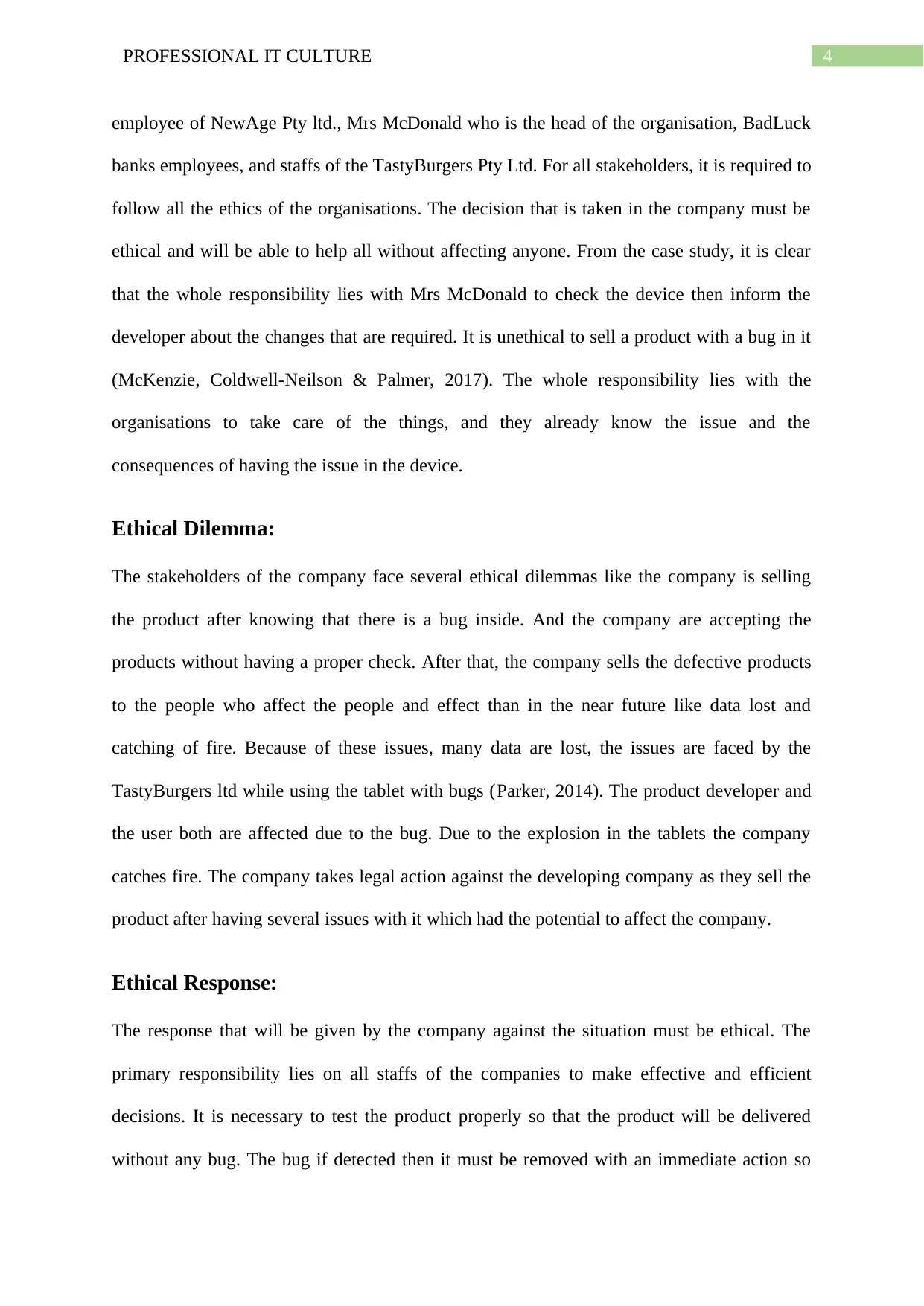
4PROFESSIONAL IT CULTURE
employee of NewAge Pty ltd., Mrs McDonald who is the head of the organisation, BadLuck
banks employees, and staffs of the TastyBurgers Pty Ltd. For all stakeholders, it is required to
follow all the ethics of the organisations. The decision that is taken in the company must be
ethical and will be able to help all without affecting anyone. From the case study, it is clear
that the whole responsibility lies with Mrs McDonald to check the device then inform the
developer about the changes that are required. It is unethical to sell a product with a bug in it
(McKenzie, Coldwell-Neilson & Palmer, 2017). The whole responsibility lies with the
organisations to take care of the things, and they already know the issue and the
consequences of having the issue in the device.
Ethical Dilemma:
The stakeholders of the company face several ethical dilemmas like the company is selling
the product after knowing that there is a bug inside. And the company are accepting the
products without having a proper check. After that, the company sells the defective products
to the people who affect the people and effect than in the near future like data lost and
catching of fire. Because of these issues, many data are lost, the issues are faced by the
TastyBurgers ltd while using the tablet with bugs (Parker, 2014). The product developer and
the user both are affected due to the bug. Due to the explosion in the tablets the company
catches fire. The company takes legal action against the developing company as they sell the
product after having several issues with it which had the potential to affect the company.
Ethical Response:
The response that will be given by the company against the situation must be ethical. The
primary responsibility lies on all staffs of the companies to make effective and efficient
decisions. It is necessary to test the product properly so that the product will be delivered
without any bug. The bug if detected then it must be removed with an immediate action so
employee of NewAge Pty ltd., Mrs McDonald who is the head of the organisation, BadLuck
banks employees, and staffs of the TastyBurgers Pty Ltd. For all stakeholders, it is required to
follow all the ethics of the organisations. The decision that is taken in the company must be
ethical and will be able to help all without affecting anyone. From the case study, it is clear
that the whole responsibility lies with Mrs McDonald to check the device then inform the
developer about the changes that are required. It is unethical to sell a product with a bug in it
(McKenzie, Coldwell-Neilson & Palmer, 2017). The whole responsibility lies with the
organisations to take care of the things, and they already know the issue and the
consequences of having the issue in the device.
Ethical Dilemma:
The stakeholders of the company face several ethical dilemmas like the company is selling
the product after knowing that there is a bug inside. And the company are accepting the
products without having a proper check. After that, the company sells the defective products
to the people who affect the people and effect than in the near future like data lost and
catching of fire. Because of these issues, many data are lost, the issues are faced by the
TastyBurgers ltd while using the tablet with bugs (Parker, 2014). The product developer and
the user both are affected due to the bug. Due to the explosion in the tablets the company
catches fire. The company takes legal action against the developing company as they sell the
product after having several issues with it which had the potential to affect the company.
Ethical Response:
The response that will be given by the company against the situation must be ethical. The
primary responsibility lies on all staffs of the companies to make effective and efficient
decisions. It is necessary to test the product properly so that the product will be delivered
without any bug. The bug if detected then it must be removed with an immediate action so
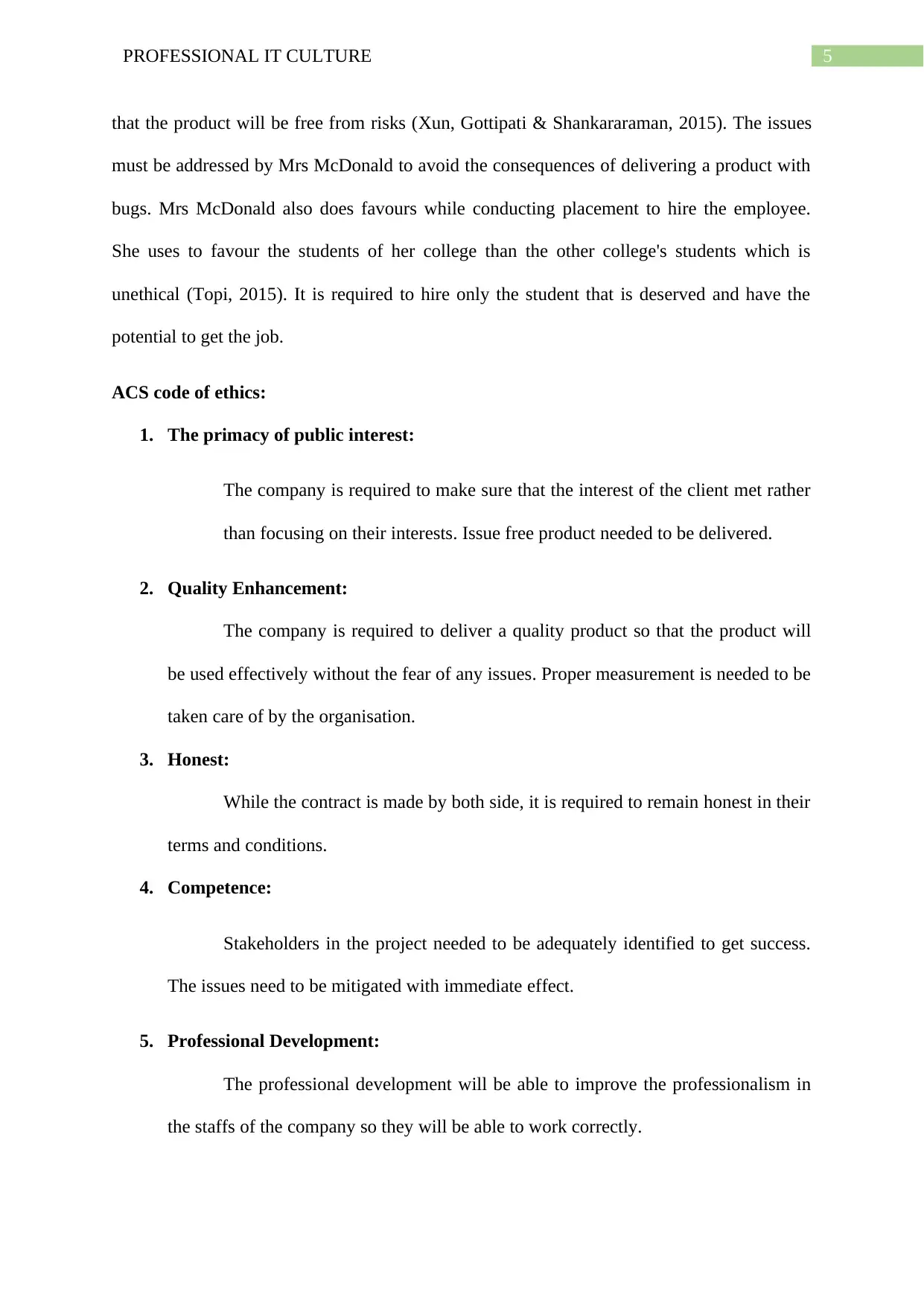
5PROFESSIONAL IT CULTURE
that the product will be free from risks (Xun, Gottipati & Shankararaman, 2015). The issues
must be addressed by Mrs McDonald to avoid the consequences of delivering a product with
bugs. Mrs McDonald also does favours while conducting placement to hire the employee.
She uses to favour the students of her college than the other college's students which is
unethical (Topi, 2015). It is required to hire only the student that is deserved and have the
potential to get the job.
ACS code of ethics:
1. The primacy of public interest:
The company is required to make sure that the interest of the client met rather
than focusing on their interests. Issue free product needed to be delivered.
2. Quality Enhancement:
The company is required to deliver a quality product so that the product will
be used effectively without the fear of any issues. Proper measurement is needed to be
taken care of by the organisation.
3. Honest:
While the contract is made by both side, it is required to remain honest in their
terms and conditions.
4. Competence:
Stakeholders in the project needed to be adequately identified to get success.
The issues need to be mitigated with immediate effect.
5. Professional Development:
The professional development will be able to improve the professionalism in
the staffs of the company so they will be able to work correctly.
that the product will be free from risks (Xun, Gottipati & Shankararaman, 2015). The issues
must be addressed by Mrs McDonald to avoid the consequences of delivering a product with
bugs. Mrs McDonald also does favours while conducting placement to hire the employee.
She uses to favour the students of her college than the other college's students which is
unethical (Topi, 2015). It is required to hire only the student that is deserved and have the
potential to get the job.
ACS code of ethics:
1. The primacy of public interest:
The company is required to make sure that the interest of the client met rather
than focusing on their interests. Issue free product needed to be delivered.
2. Quality Enhancement:
The company is required to deliver a quality product so that the product will
be used effectively without the fear of any issues. Proper measurement is needed to be
taken care of by the organisation.
3. Honest:
While the contract is made by both side, it is required to remain honest in their
terms and conditions.
4. Competence:
Stakeholders in the project needed to be adequately identified to get success.
The issues need to be mitigated with immediate effect.
5. Professional Development:
The professional development will be able to improve the professionalism in
the staffs of the company so they will be able to work correctly.
⊘ This is a preview!⊘
Do you want full access?
Subscribe today to unlock all pages.

Trusted by 1+ million students worldwide
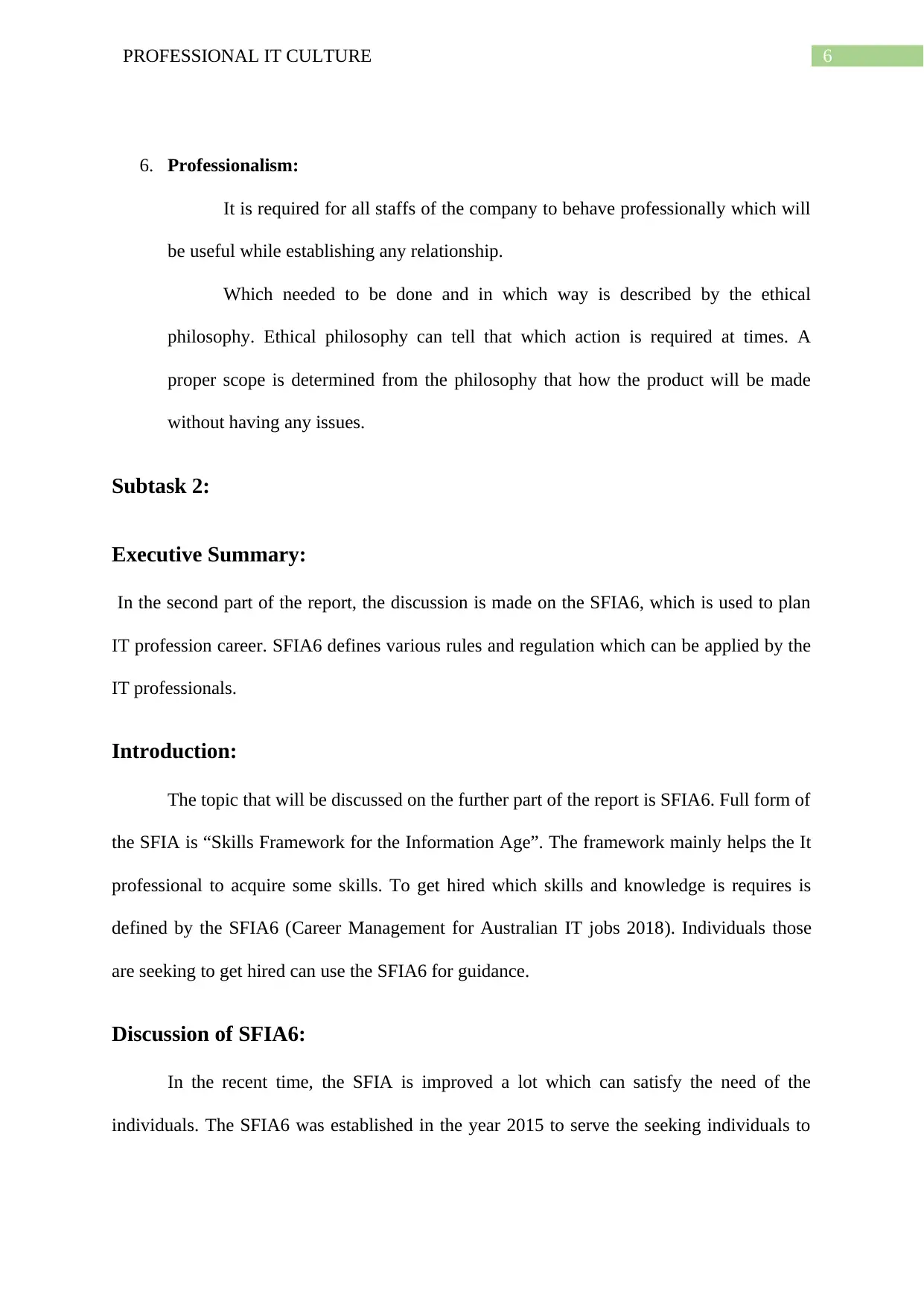
6PROFESSIONAL IT CULTURE
6. Professionalism:
It is required for all staffs of the company to behave professionally which will
be useful while establishing any relationship.
Which needed to be done and in which way is described by the ethical
philosophy. Ethical philosophy can tell that which action is required at times. A
proper scope is determined from the philosophy that how the product will be made
without having any issues.
Subtask 2:
Executive Summary:
In the second part of the report, the discussion is made on the SFIA6, which is used to plan
IT profession career. SFIA6 defines various rules and regulation which can be applied by the
IT professionals.
Introduction:
The topic that will be discussed on the further part of the report is SFIA6. Full form of
the SFIA is “Skills Framework for the Information Age”. The framework mainly helps the It
professional to acquire some skills. To get hired which skills and knowledge is requires is
defined by the SFIA6 (Career Management for Australian IT jobs 2018). Individuals those
are seeking to get hired can use the SFIA6 for guidance.
Discussion of SFIA6:
In the recent time, the SFIA is improved a lot which can satisfy the need of the
individuals. The SFIA6 was established in the year 2015 to serve the seeking individuals to
6. Professionalism:
It is required for all staffs of the company to behave professionally which will
be useful while establishing any relationship.
Which needed to be done and in which way is described by the ethical
philosophy. Ethical philosophy can tell that which action is required at times. A
proper scope is determined from the philosophy that how the product will be made
without having any issues.
Subtask 2:
Executive Summary:
In the second part of the report, the discussion is made on the SFIA6, which is used to plan
IT profession career. SFIA6 defines various rules and regulation which can be applied by the
IT professionals.
Introduction:
The topic that will be discussed on the further part of the report is SFIA6. Full form of
the SFIA is “Skills Framework for the Information Age”. The framework mainly helps the It
professional to acquire some skills. To get hired which skills and knowledge is requires is
defined by the SFIA6 (Career Management for Australian IT jobs 2018). Individuals those
are seeking to get hired can use the SFIA6 for guidance.
Discussion of SFIA6:
In the recent time, the SFIA is improved a lot which can satisfy the need of the
individuals. The SFIA6 was established in the year 2015 to serve the seeking individuals to
Paraphrase This Document
Need a fresh take? Get an instant paraphrase of this document with our AI Paraphraser
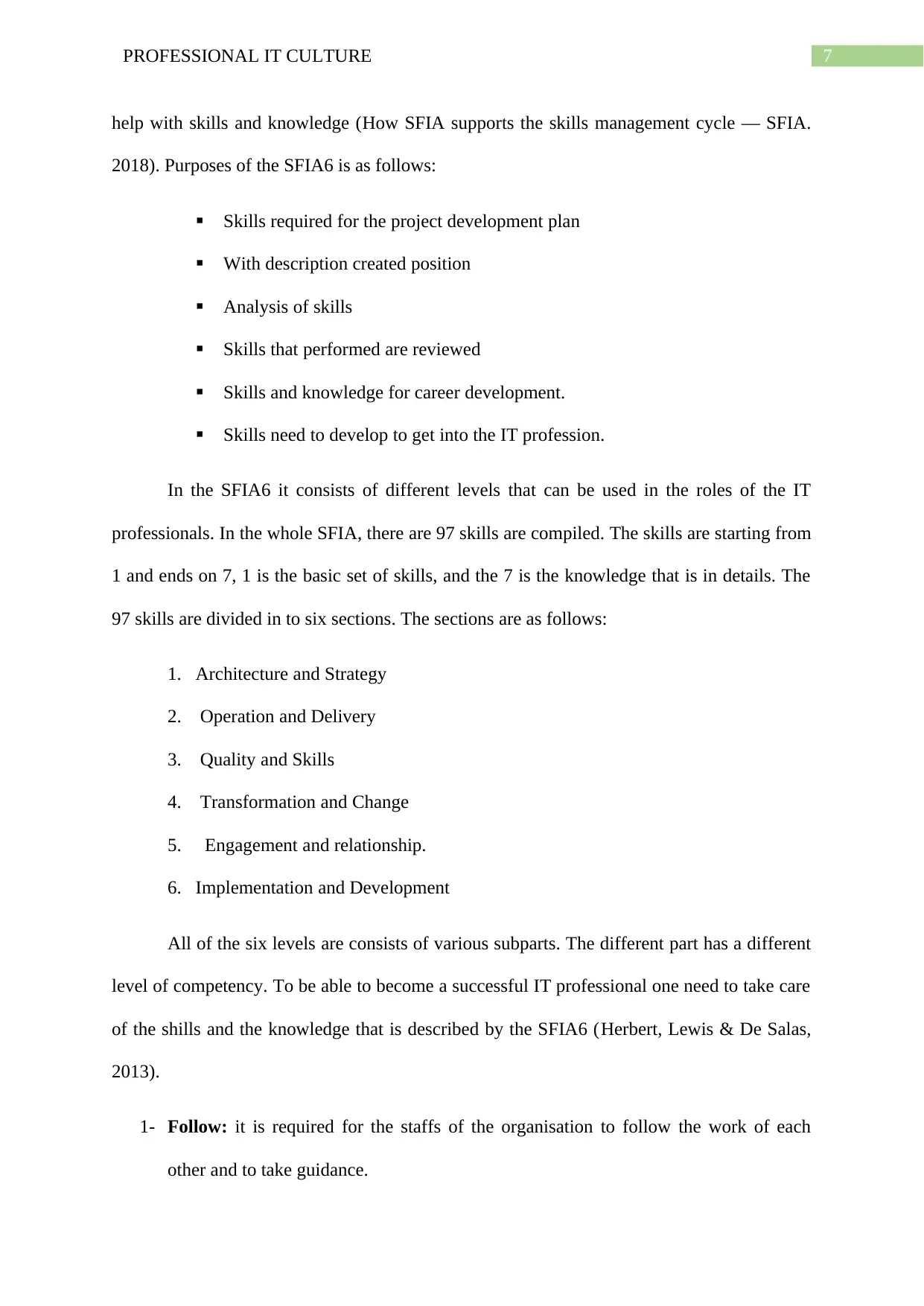
7PROFESSIONAL IT CULTURE
help with skills and knowledge (How SFIA supports the skills management cycle — SFIA.
2018). Purposes of the SFIA6 is as follows:
Skills required for the project development plan
With description created position
Analysis of skills
Skills that performed are reviewed
Skills and knowledge for career development.
Skills need to develop to get into the IT profession.
In the SFIA6 it consists of different levels that can be used in the roles of the IT
professionals. In the whole SFIA, there are 97 skills are compiled. The skills are starting from
1 and ends on 7, 1 is the basic set of skills, and the 7 is the knowledge that is in details. The
97 skills are divided in to six sections. The sections are as follows:
1. Architecture and Strategy
2. Operation and Delivery
3. Quality and Skills
4. Transformation and Change
5. Engagement and relationship.
6. Implementation and Development
All of the six levels are consists of various subparts. The different part has a different
level of competency. To be able to become a successful IT professional one need to take care
of the shills and the knowledge that is described by the SFIA6 (Herbert, Lewis & De Salas,
2013).
1- Follow: it is required for the staffs of the organisation to follow the work of each
other and to take guidance.
help with skills and knowledge (How SFIA supports the skills management cycle — SFIA.
2018). Purposes of the SFIA6 is as follows:
Skills required for the project development plan
With description created position
Analysis of skills
Skills that performed are reviewed
Skills and knowledge for career development.
Skills need to develop to get into the IT profession.
In the SFIA6 it consists of different levels that can be used in the roles of the IT
professionals. In the whole SFIA, there are 97 skills are compiled. The skills are starting from
1 and ends on 7, 1 is the basic set of skills, and the 7 is the knowledge that is in details. The
97 skills are divided in to six sections. The sections are as follows:
1. Architecture and Strategy
2. Operation and Delivery
3. Quality and Skills
4. Transformation and Change
5. Engagement and relationship.
6. Implementation and Development
All of the six levels are consists of various subparts. The different part has a different
level of competency. To be able to become a successful IT professional one need to take care
of the shills and the knowledge that is described by the SFIA6 (Herbert, Lewis & De Salas,
2013).
1- Follow: it is required for the staffs of the organisation to follow the work of each
other and to take guidance.
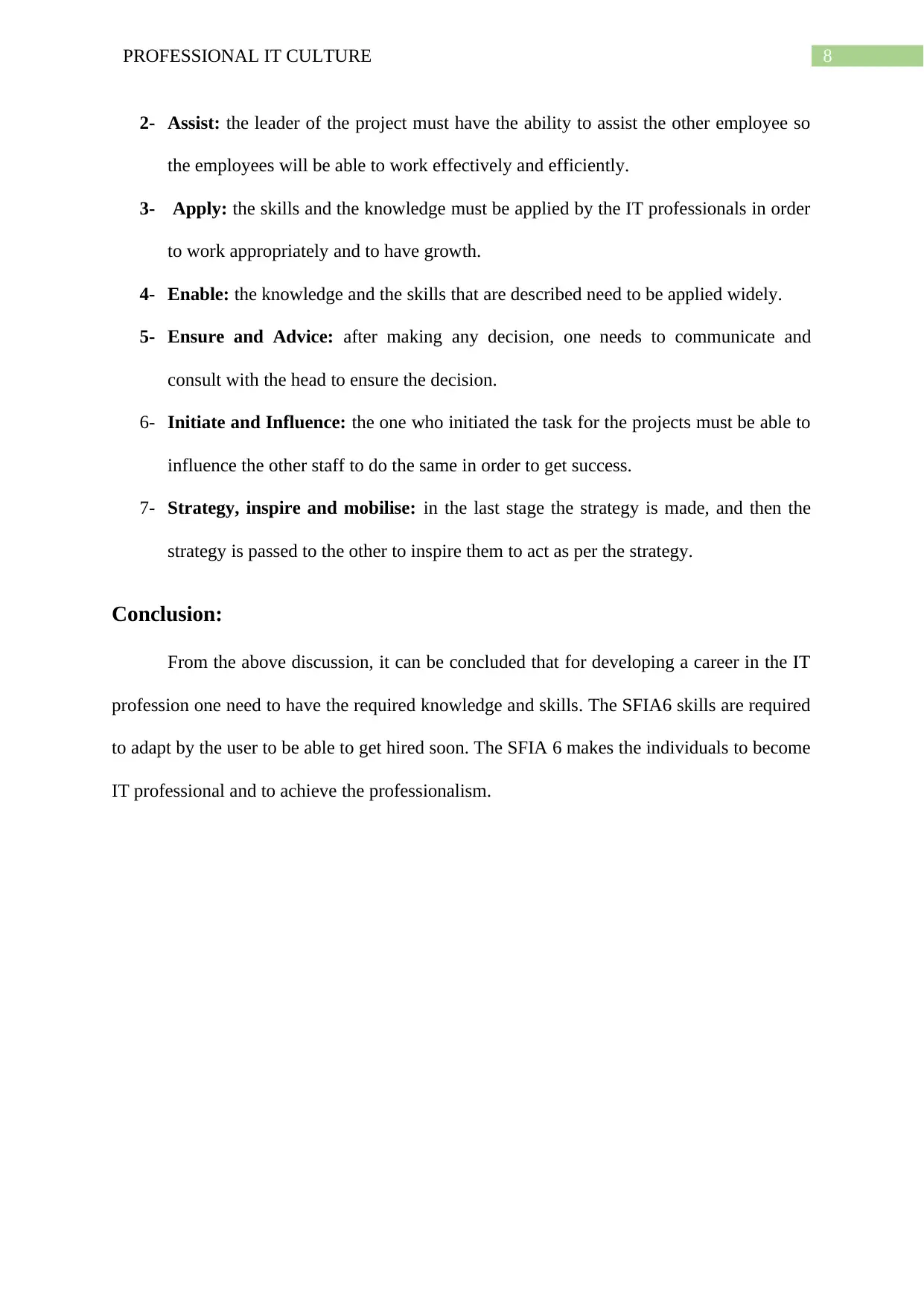
8PROFESSIONAL IT CULTURE
2- Assist: the leader of the project must have the ability to assist the other employee so
the employees will be able to work effectively and efficiently.
3- Apply: the skills and the knowledge must be applied by the IT professionals in order
to work appropriately and to have growth.
4- Enable: the knowledge and the skills that are described need to be applied widely.
5- Ensure and Advice: after making any decision, one needs to communicate and
consult with the head to ensure the decision.
6- Initiate and Influence: the one who initiated the task for the projects must be able to
influence the other staff to do the same in order to get success.
7- Strategy, inspire and mobilise: in the last stage the strategy is made, and then the
strategy is passed to the other to inspire them to act as per the strategy.
Conclusion:
From the above discussion, it can be concluded that for developing a career in the IT
profession one need to have the required knowledge and skills. The SFIA6 skills are required
to adapt by the user to be able to get hired soon. The SFIA 6 makes the individuals to become
IT professional and to achieve the professionalism.
2- Assist: the leader of the project must have the ability to assist the other employee so
the employees will be able to work effectively and efficiently.
3- Apply: the skills and the knowledge must be applied by the IT professionals in order
to work appropriately and to have growth.
4- Enable: the knowledge and the skills that are described need to be applied widely.
5- Ensure and Advice: after making any decision, one needs to communicate and
consult with the head to ensure the decision.
6- Initiate and Influence: the one who initiated the task for the projects must be able to
influence the other staff to do the same in order to get success.
7- Strategy, inspire and mobilise: in the last stage the strategy is made, and then the
strategy is passed to the other to inspire them to act as per the strategy.
Conclusion:
From the above discussion, it can be concluded that for developing a career in the IT
profession one need to have the required knowledge and skills. The SFIA6 skills are required
to adapt by the user to be able to get hired soon. The SFIA 6 makes the individuals to become
IT professional and to achieve the professionalism.
⊘ This is a preview!⊘
Do you want full access?
Subscribe today to unlock all pages.

Trusted by 1+ million students worldwide
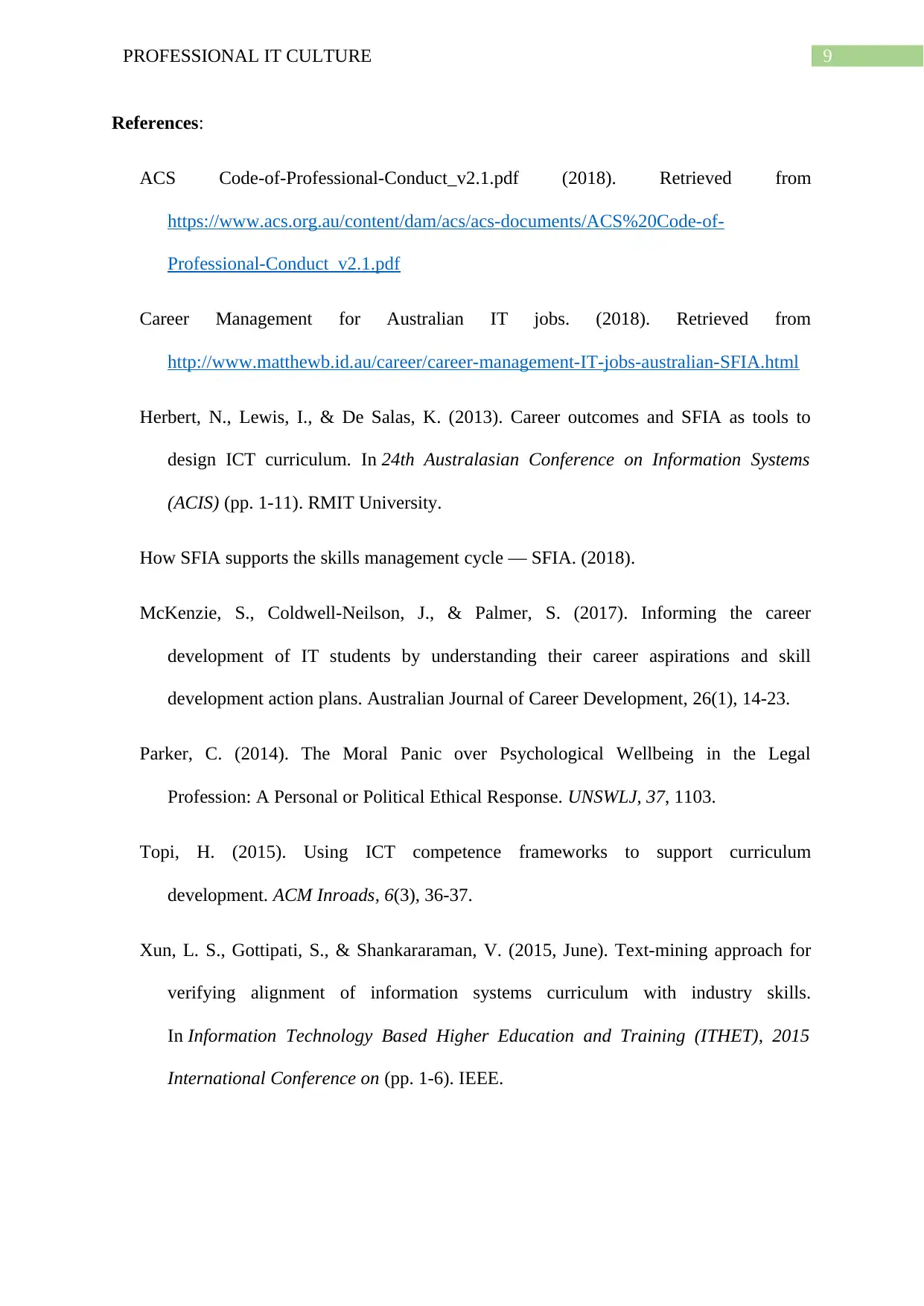
9PROFESSIONAL IT CULTURE
References:
ACS Code-of-Professional-Conduct_v2.1.pdf (2018). Retrieved from
https://www.acs.org.au/content/dam/acs/acs-documents/ACS%20Code-of-
Professional-Conduct_v2.1.pdf
Career Management for Australian IT jobs. (2018). Retrieved from
http://www.matthewb.id.au/career/career-management-IT-jobs-australian-SFIA.html
Herbert, N., Lewis, I., & De Salas, K. (2013). Career outcomes and SFIA as tools to
design ICT curriculum. In 24th Australasian Conference on Information Systems
(ACIS) (pp. 1-11). RMIT University.
How SFIA supports the skills management cycle — SFIA. (2018).
McKenzie, S., Coldwell-Neilson, J., & Palmer, S. (2017). Informing the career
development of IT students by understanding their career aspirations and skill
development action plans. Australian Journal of Career Development, 26(1), 14-23.
Parker, C. (2014). The Moral Panic over Psychological Wellbeing in the Legal
Profession: A Personal or Political Ethical Response. UNSWLJ, 37, 1103.
Topi, H. (2015). Using ICT competence frameworks to support curriculum
development. ACM Inroads, 6(3), 36-37.
Xun, L. S., Gottipati, S., & Shankararaman, V. (2015, June). Text-mining approach for
verifying alignment of information systems curriculum with industry skills.
In Information Technology Based Higher Education and Training (ITHET), 2015
International Conference on (pp. 1-6). IEEE.
References:
ACS Code-of-Professional-Conduct_v2.1.pdf (2018). Retrieved from
https://www.acs.org.au/content/dam/acs/acs-documents/ACS%20Code-of-
Professional-Conduct_v2.1.pdf
Career Management for Australian IT jobs. (2018). Retrieved from
http://www.matthewb.id.au/career/career-management-IT-jobs-australian-SFIA.html
Herbert, N., Lewis, I., & De Salas, K. (2013). Career outcomes and SFIA as tools to
design ICT curriculum. In 24th Australasian Conference on Information Systems
(ACIS) (pp. 1-11). RMIT University.
How SFIA supports the skills management cycle — SFIA. (2018).
McKenzie, S., Coldwell-Neilson, J., & Palmer, S. (2017). Informing the career
development of IT students by understanding their career aspirations and skill
development action plans. Australian Journal of Career Development, 26(1), 14-23.
Parker, C. (2014). The Moral Panic over Psychological Wellbeing in the Legal
Profession: A Personal or Political Ethical Response. UNSWLJ, 37, 1103.
Topi, H. (2015). Using ICT competence frameworks to support curriculum
development. ACM Inroads, 6(3), 36-37.
Xun, L. S., Gottipati, S., & Shankararaman, V. (2015, June). Text-mining approach for
verifying alignment of information systems curriculum with industry skills.
In Information Technology Based Higher Education and Training (ITHET), 2015
International Conference on (pp. 1-6). IEEE.
Paraphrase This Document
Need a fresh take? Get an instant paraphrase of this document with our AI Paraphraser

10PROFESSIONAL IT CULTURE
1 out of 11
Related Documents
Your All-in-One AI-Powered Toolkit for Academic Success.
+13062052269
info@desklib.com
Available 24*7 on WhatsApp / Email
![[object Object]](/_next/static/media/star-bottom.7253800d.svg)
Unlock your academic potential
Copyright © 2020–2025 A2Z Services. All Rights Reserved. Developed and managed by ZUCOL.





